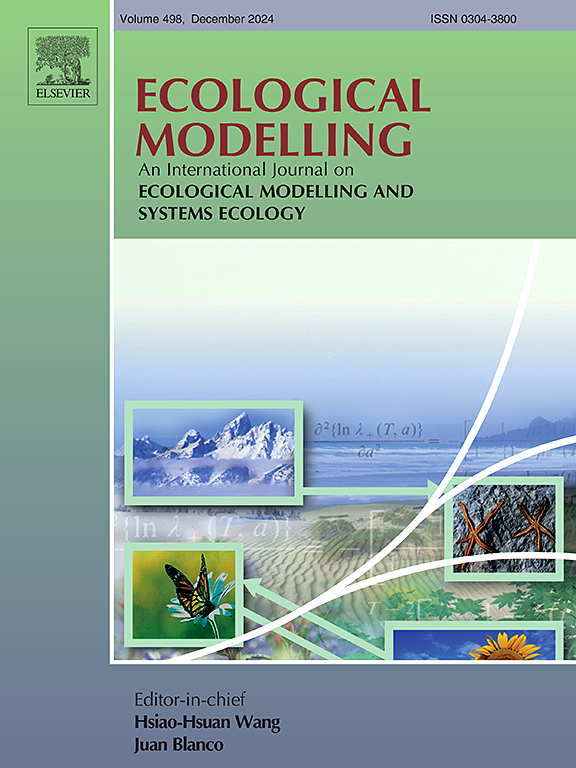Sub-seasonal forecasting of thermal stress for Swiss river fishes during heatwaves
IF 3.2
3区 环境科学与生态学
Q2 ECOLOGY
引用次数: 0
Abstract
Rising temperatures and an increasing frequency of extreme events, such as heatwaves pose major threats to ecosystems, impacting ectothermic organisms including fish. Elevated water temperatures, coupled with reduced oxygen levels, intensify stress and mortality among fish fauna, necessitating urgent action to address the impacts of heatwaves on biodiversity. Here, we propose to combine sub-seasonal to seasonal (S2S) forecasting methodologies with ecological modeling integrated with physiological parameters. Specifically, we developed a sub-seasonal forecast model designed to assess fish stress during heatwaves in Swiss rivers. We first compiled from the literature physiological parameters related to fish thermal stress to construct a thermal stress index. The developed model integrates deep-learning forecasts of water temperature with fish physiological data and species distribution modelling to offer a process-driven prediction of heat-stress responses. To validate its efficacy, we retrospectively applied the model to the 2018 heatwave across 20 measurement stations on lowland Swiss rivers, comparing its results with assessments from experts and practitioners. We found that the model successfully forecast stress peaks 2–3 weeks in advance at two validated key sites, where high mortality was reported by practitioners. By classifying fish species based on their thermal sensitivity, we identified a high vulnerability of salmonids. Applications of our model intend to alleviate climate change impacts, resulting in targeted actions to reduce local fish mortality.
热浪期间瑞士河鱼热应激的分季节预报
气温上升和热浪等极端事件日益频繁对生态系统构成重大威胁,影响到包括鱼类在内的恒温生物。水温升高,再加上氧气含量降低,加剧了鱼类动物群的压力和死亡率,需要采取紧急行动,解决热浪对生物多样性的影响。在此,我们提出将亚季节到季节(S2S)预测方法与结合生理参数的生态建模相结合。具体来说,我们开发了一个分季节预测模型,旨在评估瑞士河流热浪期间鱼类的压力。我们首先从文献中整理出与鱼类热应激相关的生理参数,构建热应激指数。该模型将水温的深度学习预测与鱼类生理数据和物种分布建模相结合,提供了一个过程驱动的热应激反应预测。为了验证其有效性,我们回顾性地将该模型应用于瑞士低地河流上20个测量站的2018年热浪,并将其结果与专家和从业者的评估进行比较。我们发现,该模型成功地提前2-3周预测了两个经过验证的关键地点的压力峰值,从业者报告了高死亡率。通过对鱼类的热敏感性进行分类,我们确定了鲑科鱼的高脆弱性。我们的模型的应用旨在减轻气候变化的影响,从而产生有针对性的行动,以减少当地鱼类的死亡率。
本文章由计算机程序翻译,如有差异,请以英文原文为准。
求助全文
约1分钟内获得全文
求助全文
来源期刊

Ecological Modelling
环境科学-生态学
CiteScore
5.60
自引率
6.50%
发文量
259
审稿时长
69 days
期刊介绍:
The journal is concerned with the use of mathematical models and systems analysis for the description of ecological processes and for the sustainable management of resources. Human activity and well-being are dependent on and integrated with the functioning of ecosystems and the services they provide. We aim to understand these basic ecosystem functions using mathematical and conceptual modelling, systems analysis, thermodynamics, computer simulations, and ecological theory. This leads to a preference for process-based models embedded in theory with explicit causative agents as opposed to strictly statistical or correlative descriptions. These modelling methods can be applied to a wide spectrum of issues ranging from basic ecology to human ecology to socio-ecological systems. The journal welcomes research articles, short communications, review articles, letters to the editor, book reviews, and other communications. The journal also supports the activities of the [International Society of Ecological Modelling (ISEM)](http://www.isemna.org/).
 求助内容:
求助内容: 应助结果提醒方式:
应助结果提醒方式:


